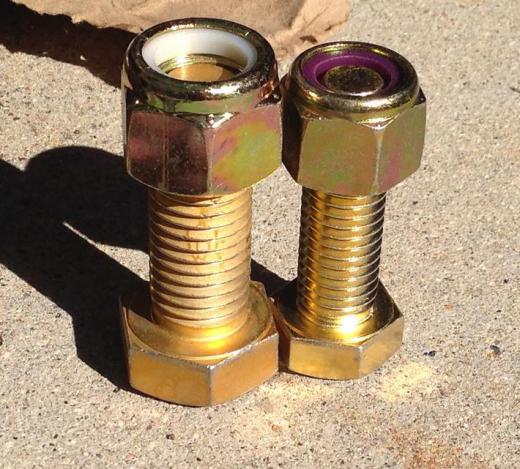A nyloc nut is a fastener that incorporates a nylon component to effectively lock the nut into position on the bolt. The nylon component of the nyloc nut has a smaller inside diameter than the actual nut, thereby acting to lock the nut in place by squeezing the nylon firmly around the bolt when tightened. Unlike a standard locking washer, the nyloc nut prevents the nut from loosening under vibration as the nylon is tightly wedged into the bolt threads and provides resistance to turning once tightened.
One common problem with standard nut-and-bolt fasteners is that they can become loose or even work themselves free over time and with vibration. Chemical thread-locking compounds work well at reducing the occurrence of loosening nuts, however, this can be very time-consuming and, in difficult-to-reach areas, nearly impossible. The nyloc nut allows a bolt to be tightened without fear of it loosening under nearly any condition, and typically there is no more difficulty in installing the nylon locking nut than a conventional non-locking nut. One drawback to using a nyloc nut is that the nut cannot be threaded tight by using fingers alone. The nylon insert requires that a wrench be used on the nut once the threads come into contact with the nylon inside the fastener.

There is typically a slight increase in price for a nyloc nut as compared to a standard nut, and this was once a concern as the locking nut was a single-use item. This means that once a locking nut has been used on a bolt, the nut must be discarded and a new nut used whenever the fastener is removed. Advances in the nylon formula have since made this requirement obsolete. The modern nylon-type locking nut can be reused many times without fear of failure, making the locking nut a viable option in most critical fastening areas. The test to reuse a locking nut is to turn the nut onto a bolt, and if the nylon provides resistance to turning using only fingers, the nut can be safely reused.
Even though the nylon locking nut can be reused in many applications, it remains a recommendation to use a fresh locking nut on any critical fastener connection. The slightest risk of failure warrants a ban on the reuse of the fastener in all critical applications, such as cylinder head bolts, connecting rod bolts and main bearing cap bolts. Modern nylon formulas permit the nyloc nut be used in many internal engine applications without concern.
